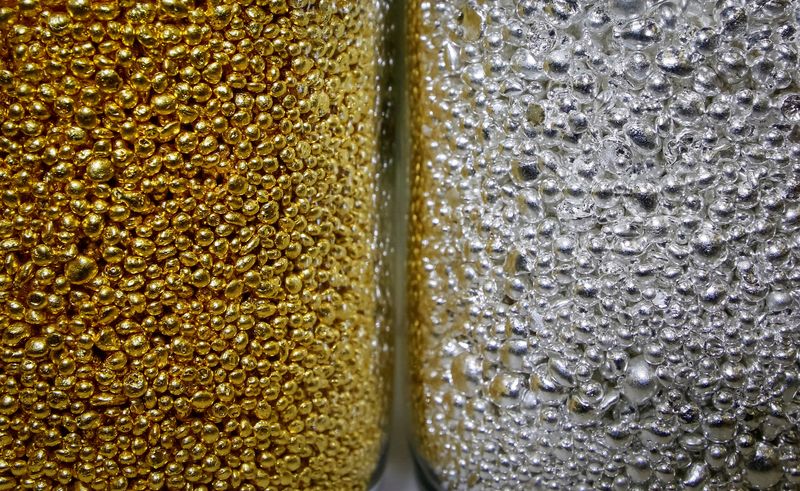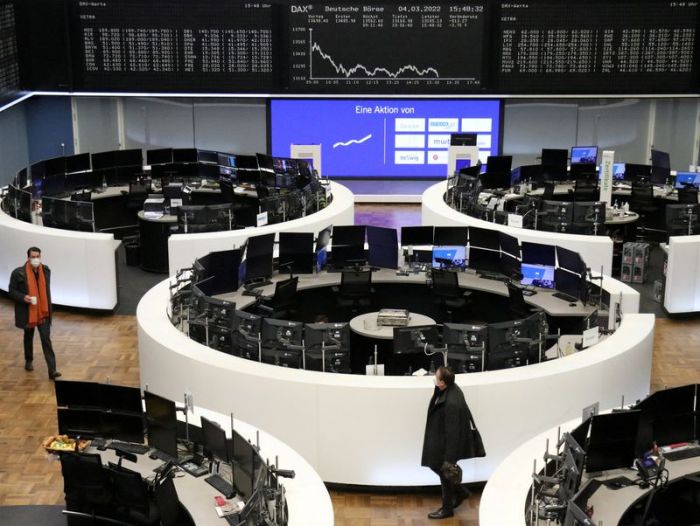LONDON/SINGAPORE (Reuters) -Commodity prices went on the rampage on Monday as industrial buyers and traders scrambled to source raw materials hit by supply disruptions caused by Russia’s invasion of Ukraine.
Nickel rocketed 76%, palladium reached a record level and gold broke through $2,000 an ounce on safe-haven appeal, while oil and wheat jumped to 14-year highs.
“Nerves of steel will be needed amid the extreme volatility,” analyst Daniel Briesemann at Commerzbank in Frankfurt said in a note.
Many markets saw rollercoaster swings, with oil and metals reversing direction as headlines flashed across traders’ screens.
The ferocity of some gains was fuelled by speculators cancelling out bearish positions, but once that buying ran its course, prices slid, traders said.
Russia’s invasion has been condemned around the world, sent more than 1.5 million Ukrainians fleeing abroad, and triggered sweeping sanctions that have isolated Russia to a degree never before experienced by such a large economy.
Commodity markets have been shaken not only by tough Western sanctions on Russia that might be widened to include oil, but logistics turmoil that has blocked the flow of grains and metals from the region.
The searing rally in raw material prices has sparked concerns over economic growth in countries still recovering from the COVID-19 pandemic.
“I suspect growth projections for 2022 around the world will need to be sharply revised lower, and it will be interesting to see what the central banks of the world will do, ” OANDA senior analyst Jeffrey Halley said in a report.
Oil prices spiked after the United States and European allies said they were considering banning imports of Russian oil.
Brent crude surged as much as 17.8% to $139.13 a barrel, its highest since July 2008, when it hit a record of $147.50, but later reversed and shed $20. [O/R]
Germany said it did not currently plan to stop energy imports from Russia.
JPMorgan analysts said oil could soar to $185 this year, while analysts at Mitsubishi UFJ Financial Group Inc said it may rise to $180 and cause a global recession.
Worries about an oil ban also roiled European gas prices, which hit record highs. [NG/EU]
The panic spurred investors to take cover in gold, regarded as a safe haven from turmoil in other markets.
Spot gold hit $2,002.40, its highest since August 2020.
Palladium bounded 15% higher to an all-time peak of $3,440 an ounce on fears of shortages of the metal used by automakers in catalytic converters, since Russia accounts for 40% of global production. Later it shed much of the gains.
Industrial metals also lurched higher, led by nickel, which surged 76% to a 15-year peak of $51,000 a tonne as global supply chains tried to price in the possible absence of supplies from Russia, the third largest nickel producer. [MET/L]
At one point, it gave up $6,500 of the gains in less than half an hour, but then rebounded.
Russia accounts for 10% of global nickel supply and 6% of the world’s aluminium output.
Both copper and aluminium touched record peaks, but later turned tail and went into the red.
Chinese ferrous futures also gained ground, with iron ore hitting a six-month high after a downbeat economic forecast over the weekend lifted expectations for more infrastructure spending in the world’s second largest economy.
On agricultural markets, Chicago wheat futures rose more than 7%, hitting a 14-year top as traders worried about the impact the Ukraine conflict is having on supplies from Russia, the world’s biggest wheat exporter, and Ukraine. [GRA/]
With Ukrainian ports closed and operators reluctant to trade Russian wheat in the face of Western financial sanctions, buyers are trying to find alternative suppliers.
Russia and Ukraine together account for about 29% of global wheat exports and 19% of corn exports.
(Additional reporting by Bozorgmehr Sharafedin, Scott DiSavino, Michael Hogan, Asha Sistla, Marwa Rashad, Eileen Soreng and Pratima Desai; Editing by Jan Harvey and Ed Osmond)



















